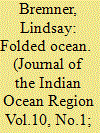|
|
|
Sort Order |
|
|
|
Items / Page
|
|
|
|
|
|
|
| Srl | Item |
| 1 |
ID:
138230


|
|
|
|
|
| Summary/Abstract |
This paper gives an account of the disappearance of Malaysian Airways Flight MH370 into the southern Indian Ocean in March 2014 and analyses the rare glimpses into remote ocean space this incident opened up. It follows the tenuous clues as to where the aeroplane might have come to rest after it disappeared from radar screens – seven satellite pings, hundreds of pieces of floating debris and six underwater sonic recordings – as ways of entering into and thinking about ocean space. The paper pays attention to and analyses this space on three registers – first, as a fluid, more-thanhuman materiality with particular properties and agencies; second, as a synthetic situation, a composite of informational bits and pieces scopically articulated and augmented; and third, as geopolitics, delineated by the protocols of international search and rescue. On all three registers – as matter, as data and as law – the ocean is shown to be ontologically fluid, a world defined by movement, flow and flux, posing intractable difficulties for human interactions with it.
|
|
|
|
|
|
|
|
|
|
|
|
|
|
|
|
| 2 |
ID:
130873


|
|
|
|
|
| Publication |
2014.
|
| Summary/Abstract |
This paper presents experimental research on the Indian Ocean being undertaken within the context of what has been termed architecture's contemporary geographic turn. It investigates how oceanic practices and protocols fold into spatial and architectural products on land, figuring both sea- and land-based logics. It frames this ocean through three tropes: as contact zone, with which are associated ideas of creolisation, transnationalism, entanglement, compaction and multi-polarity; as circulator with which are associated ideas of connectivity, passage, lane, route, choke point, network, port, dock and deposit; and as ecology, with which are associated ideas of liquidity, cycle, rhythm and climate change. The paper introduces these tropes and investigates sites brought into focus through them, highlighting the wider global dynamics or processes they reveal. It concludes with provisional thoughts about what these amphibious sites offer for understandings of architecture and urbanism in today's hyper-articulated, globalised world.
|
|
|
|
|
|
|
|
|
|
|
|
|
|
|
|
|
|
|
|
|